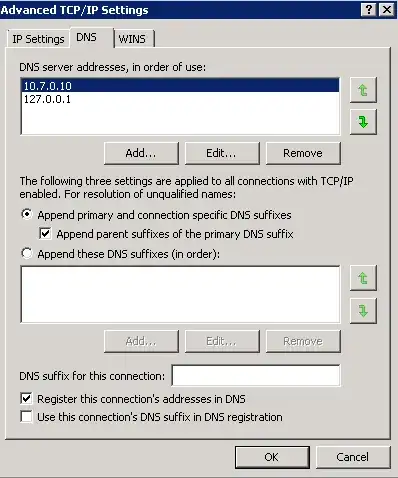Can someone explain TCT/IP > Properties > Advanced > 'DNS' tab please? I know what DNS, primary DNS suffix and DNS suffix are, but this tab has some confusing properties.

Can someone explain TCT/IP > Properties > Advanced > 'DNS' tab please? I know what DNS, primary DNS suffix and DNS suffix are, but this tab has some confusing properties.

Here's a shot:
DNS server addresses, in order of use:
This lists the name servers that your machine will contact for DNS resolution, in the order they will be contacted should one higher in the list be unreachable.
Append primary and connection specific DNS suffixes
When performing a name resolution request, this will append the dns suffix of the machine and DNS suffix for this connection (see below) to the host name in a dns query, if the query is not for a fully qualified host name. This helps to speed up queries so that they get sent to the proper authoritative server quicker (or at all).
Append parent suffixes of the primary DNS suffix
This does the same as the above, except it will take parent suffixes instead. For example, if your primary DNS suffix is somesub.mydomain.com then it will append .mydomain.com and .com to queries.
Append these DNS suffixes (in order)
This is a list that you can define of additional suffixes to add to queries.
DNS suffix for this connection
This is the DNS domain that you want that connection to be associated with. This is automatically set when the machine is part of an Active Directory domain.
Register this connection's addresses in DNS
When this is checked your machine will attempt to dynamically create DNS records (ie- register itself) in the zone associated with the connection. This will either be the Active Directory domain your machine is a member of or the DNS suffix listed in the above setting if you have the next setting checked.
Use this connection's DNS suffix in DNS registration
If this is checked then when attempting to dynamically register with DNS (if enabled) it will try to register itself in the zone of the DNS suffix for this connection.
(Note: This is in addition to the regular registration of the "full computer name". Not instead of. (See TechNet))
The "DNS suffix for this connection" sets a DNS suffix for this adapter only (which would be in addition to the primary DNS suffix, if one exists). This is mostly useful for a multihomed computer or for a computer in a workgroup which doesn't have a primary DNS suffix.
I use this setting on my home computers (which aren't joined to a Windows domain) in concert with the "Register this connection's address in DNS" setting so that they all register in my DNS server (in a specific zone) and I have common and consistent name resolution for all of my computers.